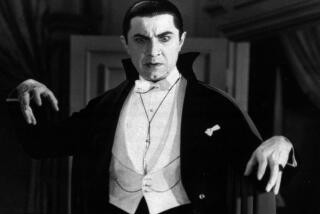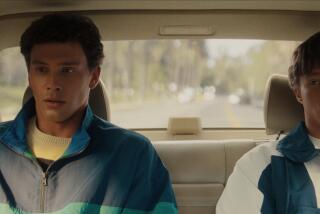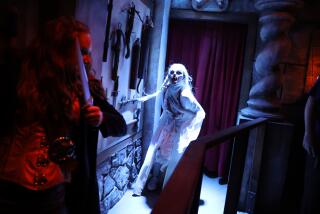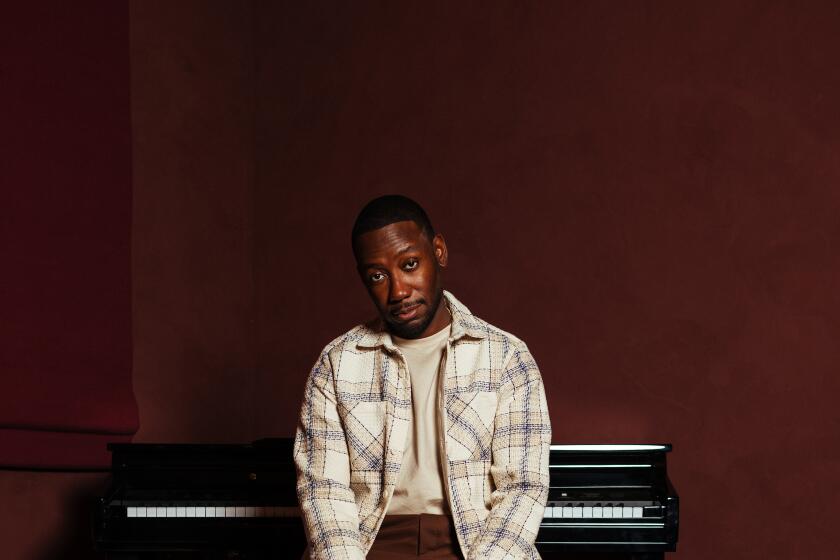Real Fear May Lie in the Hidden Heart of Evil
Shortly after James Whale’s “Frankenstein” opened in November 1931, the manager of a certain Granada Theater received a 2 a.m. wake-up call. “I can’t sleep,” said the unhappy patron. “So I’ll be darned if you’re going to sleep either!”
The anecdote, recounted in James Curtis’ “James Whale: A New World of Gods and Monsters,” is scary--if you’re a theater manager: A customer with your home phone number? Horrifying.
In 1931, though, sound film was in its infancy, the modern horror flick was finding a footing and Boris Karloff and “Frankenstein” were the stuff of insomnia.
What scares us now? It’s hard to scare people, particularly when the conventional methods have been worked to death. The “Nightmare on Elm Street” and “Halloween” movies, or such cult classics as “The Texas Chainsaw Massacre” or “Last House on the Left,” were novel in their gruesomeness. But their descendants went to the well so often that “Scream” and “Scary Movie” became all but inevitable.
The most recent generation--”Urban Legends: Final Cut” or “Final Destination” (whose multiple air disasters would make it unreleasable now) or “Bride of Chucky”--are all movies in which irony, if the filmmaker is lucky, far eclipses fright. And it’s no better in the better neighborhoods: At the presumably high end of the contemporary horror biz, “Hannibal” squandered its inheritance (the delicious dread of “The Silence of the Lambs”) by forgetting that very little Lecter goes a long, long way.
In 1931, Whale could elicit genuine alarm in an audience, but movies were young, viewers were green and Whale had the counter-revolutionary idea of making a monster human, thus closing the gap between evil and us. Conversely, “The Bride of Frankenstein” has remained Whale’s real classic not because of its fright quotient but because of Whale’s precocious understanding of the genre’s potential campiness and the symbiotic relationship between laughter and fright: Go to the worst contemporary horror flick and the jolt of fear (usually prompted by some camera trick) is relieved by laughs--laughs born of embarrassment or laughs born of relief.
So, what really scares us at the movies? The budget of “Pearl Harbor”? Sure. The acting of Robin Williams? Quite possibly. “Glitter”? Definitely (but not as much as “Glitter II”). We also have an involuntary reaction to things that jump up or out or suddenly loom behind a nervous heroine in her bathroom mirror--the way they did with numbing regularity in Robert Zemeckis’ “What Lies Beneath,” a film of Hitchcockian pretensions but very few moments of scariness that weren’t the dramatic equivalent of a hammer to the kneecap.
Why is it that Hitchcock’s “Psycho” (1960) retains the ability to unnerve people (and keep them unwashed), while Tod Browning’s “Dracula” (1931), which put its original audiences into a swoon, is now virtual camp? Possibly for the same reason Browning’s “Freaks” (1932), his audacious melodrama set amid a circus sideshow, remains a thing of dread. Or why “The Blair Witch Project” (1999), the oft-derided but highly profitable faux documentary, was compared in its style to the disorienting design of a nightmare?
To our credit as an audience, the difference is plausibility: Though the purely supernatural doesn’t cut it anymore, examinations of profound human failing and/or aspects of our primal fears rattle our cages. All of which means the definition of horror has changed. Has there been a movie over the last several years that was more soul-shaking than “Requiem for a Dream”? And what was at its root? Weakness of a self-annihilating degree. Director Darren Aronofsky might have made Ellen Burstyn’s refrigerator walk across her kitchen, but it was the more believable moments--or at least the ones Aronofsky made believable--that were terrifying: Jared Leto, firing a fatal syringe into his abscessed arm in the search of one more high; Jennifer Connelly letting her coke addiction lead her into sexual exploitation. It’s a kind of madness we’re watching, and with madness--be it the undead lunacy of the original “Nosferatu” or the intimidating unpredictability of Frank in David Lynch’s “Blue Velvet”--the result is fear.
Is there a scarier movie than 1979’s “Apocalypse Now” (or, of course, 2001’s “Apocalypse Now Redux”)? Francis Ford Coppola’s classic is an examination of madness not on a human scale but on a national one. You might then say that a film like “The Missiles of October” is a horror movie too, or, for that matter, anything made in the Soviet Union during the Stalinist regime.
But these aren’t movies we think of as conventional horror. One of the best that fits neatly in the genre is “The Haunting,” the 1963 original, not the 1999 remake with Catherine Zeta-Jones. Although almost nothing overtly horrible ever happens, and everything--almost everything--can be explained away rationally, it remains a scary movie. There is that moment when Julie Harris and Claire Bloom are in adjoining beds, in the dark, talking and holding hands and when the lights come up they find they’re actually on opposite sides of the room. Harris is supposed to be a little unstable, you see. But we really can’t explain away Bloom.
The remake is a good example of hackneyed direction, a reliance on cliched chills and a tacit assumption that what they’re giving you is scary. No one in the audience can help levitating out of his or her seat when the skeleton springs out of the grating in the hearth, but it’s a reflex action; pretend to throw a punch at someone’s face, they’ll still cover up. And “The Haunting II” is full of mock punches.
The reverse is to use the kind of subtle psychological manipulation and power of suggestion that can cause a real uproar in an audience’s psyche and leave people disoriented for days. Two films that did, in various ways and various degrees of success, are “The Others,” the current Nicole Kidman shocker, and 1961’s “The Innocents,” William Archibald and Truman Capote’s adaptation of Henry James’ “The Turn of the Screw” (which also inspired “The Others,” if not contractually).
In the former, Kidman’s war widow keeps her two children out of direct sunshine, instructs the new servants in her obsessive-compulsive domestic routine and seems to be a mind under siege by spirits playing havoc with both her house and her sanity. The kicker to the film, one that nearly forgives all the earlier overplayed direction, is that we have never known the nature of those spirits at all.
In “The Innocents,” on the other hand, it’s the nature of the mind we don’t know. Deborah Kerr’s newly hired nanny is increasingly suspicious that evil is lurking around the house. We, on the other hand, are never quite sure if the evil is inside her, or just the insanity.
So, in “The Innocents”--as in “The Others” and “The Haunting” and even “The Blair Witch Project”--it’s that element of insecurity in our perceptions, in our characters or in ourselves that causes the tremor in our souls and makes for real horror at the movies. They say that what you don’t know won’t hurt you. But, at the movies, it might just scare you half to death.
More to Read
Only good movies
Get the Indie Focus newsletter, Mark Olsen's weekly guide to the world of cinema.
You may occasionally receive promotional content from the Los Angeles Times.










